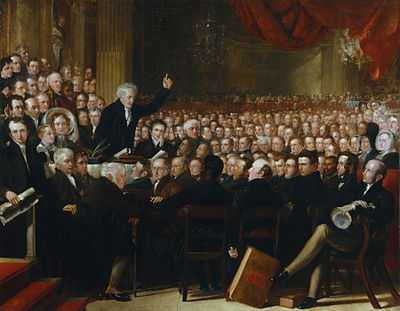Elizabeth Pease Nichol
| Elizabeth Pease Nichol | |
|---|---|
|
Pease in 1840.[1] | |
| Born | 5 January 1807, Darlington, England |
| Died | 3 February 1897, Edinburgh, Scotland |
| Nationality | British |
| Occupation | Campaigner |
| Religion | Quaker |
Elizabeth Pease Nichol (5.1.1807–3.2.1897) was an abolitionist, anti-segregationist, woman suffragist, chartist[2] and anti-vivisectionist in 19th century Great Britain.[3] She was active in the Peace Society, the Temperance Movement and founded the Darlington Ladies Anti-Slavery Society. In 1853 she married Dr. John Pringle Nichol (1804–1859), Regius Professor of Astronomy at the University of Glasgow. She was one of about six women who were in the painting of the World Anti-Slavery Convention of 1840.[1]
Biography
Early life
Elizabeth Pease was born in Darlington, England to Joseph Pease and his wife Elizabeth Beaumont, who were members of the Society of Friends (Quakers). Her father started the Peace Society the year of her birth, the same year that Great Britain abolished the slave trade in its empire, while allowing slavery to continue.
Public life

- ^ The Anti-Slavery Society Convention, 1840, Benjamin Robert Haydon, 1841, National Portrait Gallery, London, NPG599, Given by British and Foreign Anti-Slavery Society in 1880
By 1837, Pease was leading the Darlington Ladies Anti-Slavery Society. Charles Stuart, an Anti-Slavery abolitionist and lecturer, encouraged her to send a female delegate or attend a national society being formed by Joseph Sturge. Pease resisted more public involvement, as she did not seek the limelight but wanted to work locally for the causes she held to be important.[4]
In 1840, Pease travelled to London to attend the World Anti-Slavery Convention beginning on 12 June, as did her friend, Eliza Wigham who was secretary of the Edinburgh Ladies Anti-Slavery Society. Before the conference started, she met American activists Lucretia Mott and Elizabeth Cady Stanton.[5] These women were amongst the otherwise all-male American delegates at the conference.
Before the convention opened, the British organiser Joseph Sturge told the six women delegates they would not be allowed to participate. Leading English Anti-Slavery members had rebuked him for thinking this "insane innovation, this woman-intruding delusion," should be allowed. At the time, women did not generally participate in such public political and civic activities, and many people found it socially unacceptable. In addition, women attendees were required to sit in segregated areas out of sight of the male delegates.
Supporting the women's participation were some of the male delegates from the United States, including George Bradburn, Wendell Phillips, James Mott, William Adam, Isaac Winslow, J. P. Miller and Henry B. Stanton. William Lloyd Garrison, who did not arrive until the 17th,[6] refused to take his seat until women had equality in seating.[7] Unlike his fellow countrymen, Baptist Henry Grew spoke in favour of the men's right to exclude women, despite his daughter's being one of the excluded.[8] The American women had to join British women observers, such as Lady Byron, Anne Knight and Pease, in a segregated area.
The picture above shows Pease in a painting commemorating the international event. It attracted delegates from the United States, France, Haiti, Australia, Ireland, Jamaica and Barbados, as well as Great Britain.[1] With the exception of Mary Clarkson, the women are portrayed to the far right, with none in the foreground.
Pease attended with Anne Knight and several other friends, but it was only Knight and Pease of their circle who were among the women notables chosen for the painting. Other women included were Amelia Opie, Baroness Byron, Mary Anne Rawson, Mrs John Beaumont, Elizabeth Tredgold, Mary Clarkson and, at the back, Lucretia Mott.[1]
Marriage and family
In 1853 Pease married Dr. John Pringle Nichol (1804–1859), Regius Professor of Astronomy at the University of Glasgow and she moved to Edinburgh to live with him. Her family opposed the marriage, as Nicholl was a Presbyterian. According to the endogamous rules of the Quakers, Pease had to leave the Society of Friends.
References
- ↑ 1.0 1.1 1.2 1.3 The Anti-Slavery Society Convention, 1840, Benjamin Robert Haydon, accessed 19 July 2008
- ↑ Clare Midgley, Women Against Slavery, p. 152
- ↑ Oxford Dictionary of National Biography
- ↑ Clare Midgley, Women Against Slavery, p. 51
- ↑ Elizabeth Crawford, The Women's Suffrage Movement, p. 462, accessed 4 August 2008
- ↑ Frances H. Bradburn, A Memorial of George Bradburn, 1883
- ↑ Harriet H. Robinson, Massachusetts in the woman suffrage movement. A general, political, legal and legislative history from 1774, to 1881, accessed 19 July 2006
- ↑ Reforming Men and Women: Gender in the Antebellum City, Bruce Dorsey, p.179, 2002, ISBN 0-8014-3897-7 accessed 21 July 2008
